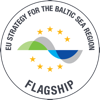Andrzej Podscianski of the Polish National Management Authority and coordinator of the EUSBSR Policy Area Nutri in Poland presented the topic “Towards combating eutrophication – EU macro-regional approach”. The presentation covered three main issues. First was the eutrophication status: one of the main environmental threats to the BSR, with the greatest contributors being Poland, Sweden and Russia. There followed the issue of classification of nutrient sources and their main pathways of to the sea. Finally, he examined internal loading of dissolved phosphorus as a serious issue.
Andrzej Podscianski then explored the role of regional strategies to address these issues. Amongst his proffered approached were the EUSBSR action plan for reducing nutrient inputs to the sea to acceptable levels with specific Nutri targets and indicators. He also introduced recent reports and working documents as well as highlighting to important upcoming events: the 7th Strategy Forum of the EUSBSR, 8-9 Nov 2016 and the HELCOM EUSBSR workshop on internal nutrient reserves, 28-29 Nov 2017, in Gothenburg.
Anna Saarentaus of the John Nurminen Foundation gave a talk on removing excess nutrients from sea water. She presented the project Pilot Fish: targeted fishing of under-utilised cyprinid fish like bream and roach. The environmental benefits include the removal of nutrients from the coastal marine ecosystem with a positive impact on marine food web and coastal ecosystem. The project has great future potential, with a significant amount of nutrients removed with each fish catch (1 million kilograms of fish = 8 tonnes of phosphorus). Anna Saarentaus emphasised the role conscious consumer choice plays and can be enhances by tools such as the “Baltic Sea calculator”. The tool calculates the average footprint and the Baltic Sea footprint of Finnish people: www.syke.fi/balticseacalculator
It turned out that food is the main source for nutrients, followed by wastewater, energy consumption and other consumption. Therefore, if the average consumer wants to reduce nutrients in the sea, the answer is to eat more wild fish and vegetables.
Susanne Minnhagen, of Kalmar Municipality and Per Dolmer of Orbicon presented the topic of mussel farming in the BSR. Mussels function as filtration systems and are a vital element of circular bioeconomy. The current types of mussel production are: Smartfarm, Long Lines and Bottom culture. The aim of the Baltic Blue Growth project (Interreg) is to get necessary stakeholders to collaborate in order to develop a successful mussel farming value chain. Mussels grow better in high salinity, therefore in the Western Baltic (6-8 cm) better than in Baltic Proper (3-4 cm). Costs faced by mussel farmers vary due to the large size needed for mussels sold for human consumption and comparatively high labour costs. The project is working with case studies to investigate further, including the mussel farm for nutrient extraction at Hjarno Havbrug that combines rainbow trout and mussel farming.
The two speakers gave an overview of the status of BSR mussel farming in different countries:
Gun Lindberg of Västervik Municipality presented the topic of nutrient harvesting from a municipal perspective. Regional projects and cooperation are well established in western Sweden, as it is a good place for fishing, eutrophication is a big challenge. She demonstrated the approach with the aid of four real cases. The “Blue Vision Västervik” combines a local action plan for eutrophication with 20 actions. Strategies are e.g. to improve water quality while increasing agricultural production and close the nutrient loop by working with local producers. Secondly, mussel farming in the Västervik archipelago has reached a level of 10 tonnes output in every 2-year period. And thirdly, flotation sludge from the fish industry, especially from the European sprat, has high potential to be turned into biogas. The fourth case was a pilot study of selective fishing of sticklebacks, looking into the ecology of fish species and potential ecosystem effects of fishing, digestion residues as a fertilizer, anaerobic digestion of fish to biogas.

The key question throughout the session was: who will pay the cost to reduce eutrophication? The farmers, the public, or both?
Nutrient harvesting is in general positive for local economy as it reduces a) algae blooms, and b) the risk to the tourism industry.
Workshop's presentations:
Nutrient harvesting – what’s in it for the municipality? Part 2 by G. Lindberg
Tags: event, SUBMARINER Network, Baltic Sea Region, Germany, Schleswig-Holstein



